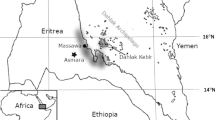Abstract
Genetic divergence in Ditrema jordani was investigated from sequence variations on the mitochondrial cytochrome b gene. Clear genetic differences were found between specimens collected from the Mie and Shizuoka prefectures (westward of Izu Peninsula) and those from the Kanagawa and Chiba prefectures (eastward of Izu Peninsula). The uncorrected genetic distance between the two groups, which may represent separate taxa, was much greater (3.1–3.7%) than that between D. temminckii and D. viride (1.1–2.4%), and between two subspecies of D. temminckii (0.8–1.3%), suggesting that the Izu Peninsula acts as a stable geographic barrier to gene flow between the D. jordani groups. The clear genetic divergence between the two geographic populations of D. jordani may be partly related to direct development (viviparity) and low dispersal ability in the genus.


Similar content being viewed by others
References
Bernardi G (2000) Barriers to gene flow in Embiotoca jacksoni, a marine fish lacking a pelagic larval stage. Evolution 54:226–237
Bernardi G (2009) The name of the father: conflict between Louis and Alexander Agassiz and the Embiotoca surfperch radiation. J Fish Biol 74:1049–1055
Bernardi G, Bucciarelli G (1999) Molecular phylogeny and speciation of the surfperches (Embiotocidae, Perciformes). Mol Phylogenet Evol 13:77–81
Bernardi G, Vagelli A (2004) Population structure in Banggai cardinalfish, Pterapogon kauderni, a coral reef species lacking a pelagic phase. Mar Biol 145:803–810
Felsenstein J (1985) Confidence limits on phylogenies: an approaching using bootstrap. Evolution 39:783–791
Hasegawa M, Kishino H, Yano TA (1985) Dating of the human–ape splitting by a molecular clock of mitochondrial DNA. J Mol Evol 22:160–174
Hatooka K (2002) Embiotocidae. In: Nakabo T (ed) Fishes of Japan with pictorial keys to the species, English edn. Tokai Univ Press, Tokyo, pp 917, 1567
Huelsenbeck JP, Crandall KA (1997) Phylogeny estimation and hypothesis testing using maximum likelihood. Ann Rev Ecol Syst 28:437–466
Katafuchi H, Nakabo T (2007) Revision of the genus Ditrema (Embiotocidae) from East Asia. Ichthyol Res 54:350–366
Knowlton N (1993) Sibling species in the Sea. Annu Rev Ecol Syst 24:189–216
Palumbi SR (1994) Genetic divergence, reproductive isolation, and marine speciation. Annu Rev Ecol Syst 25:547–572
Palumbi SR (1996) Nucleic acids II: the polymerase chain reaction. In: Hillis DM, Mortiz C, Mable BK (eds) Molecular systematics. Sinauer, Sunderland, pp 205–248
Planes S, Doherty PJ (1997) Genetic relationships of the colour morphs of Acanthochromis polyacanthus (Pomacentridae) on the northern Great Barrier Reef. Mar Biol 130:109–117
Posoda D, Crandall KA (1998) MODELTEST: testing the model of DNA substitution. Bioinformatics 14:817–818
Saitou N, Imanishi T (1987) The neighbor-joining method: a new method for reconstructing phylogenetic trees. Mol Biol Evol 4:406–425
Swofford DL (2001) PAUP*: phylogenetic analysis using parsimony (* and other methods), version 4.0. Sinauer Associates, Sunderland
Taira T (1991) The formation of the Japanese Archipelago. Iwanami-Shoten, Tokyo
Zardoya R, Doadrio I (1999) Molecular evidence on the evolutionary and biogeographical patterns of European cyprinids. J Mol Evol 49:227–237
Acknowledgments
We are grateful to the following for help in collecting specimens: K. Sakai (Noto Marine Center), K. Matsuda (Mie Prefectural Science and Technology Promotion Center), K. Hayama and M. Fukumoto (MARUSE), S. Masuda (Kawasaki Fish Market, Ltd.), S. Ito (Chiba Pref.), H. Kawashima and S. Kawabata (Shizuoka Pref.), R. Doiuchi (Fisheries Experimental Station, Wakayama Prefectual Research Center of Agriculture, Forestry and Fisheries), J.K. Kim (NFRDI), T. Wada, Y. Fukunishi and K. Matsuda (Kyoto University), M. Aritaki and M. Nakagawa (National Center for Stock Enhancement, Fisheries Research Agency). We thank K. Hagiwara (Yokosuka City Museum) for information on collecting specimens and H. Kishimoto (Tokai University) for providing the use of laboratory facilities. We are also much indebted to K. Nakayama (Kyoto University) and R. Doiuchi, who give advice on molecular techniques, and G.S. Hardy (Ngunguru, New Zealand), who read the initial manuscript and offered helpful comments. This study was supported in part by a Grant-in-Aid for Scientific Research (B) from Japan Society for the Promotion of Science (JSPS) (20370034).
Author information
Authors and Affiliations
Corresponding author
About this article
Cite this article
Katafuchi, H., Kai, Y. & Nakabo, T. Genetic divergence in Ditrema jordani (Perciformes: Embiotocidae) from the Pacific coast of southern Japan, as inferred from mitochondrial DNA sequences. Ichthyol Res 58, 90–94 (2011). https://doi.org/10.1007/s10228-010-0190-2
Received:
Revised:
Accepted:
Published:
Issue Date:
DOI: https://doi.org/10.1007/s10228-010-0190-2




